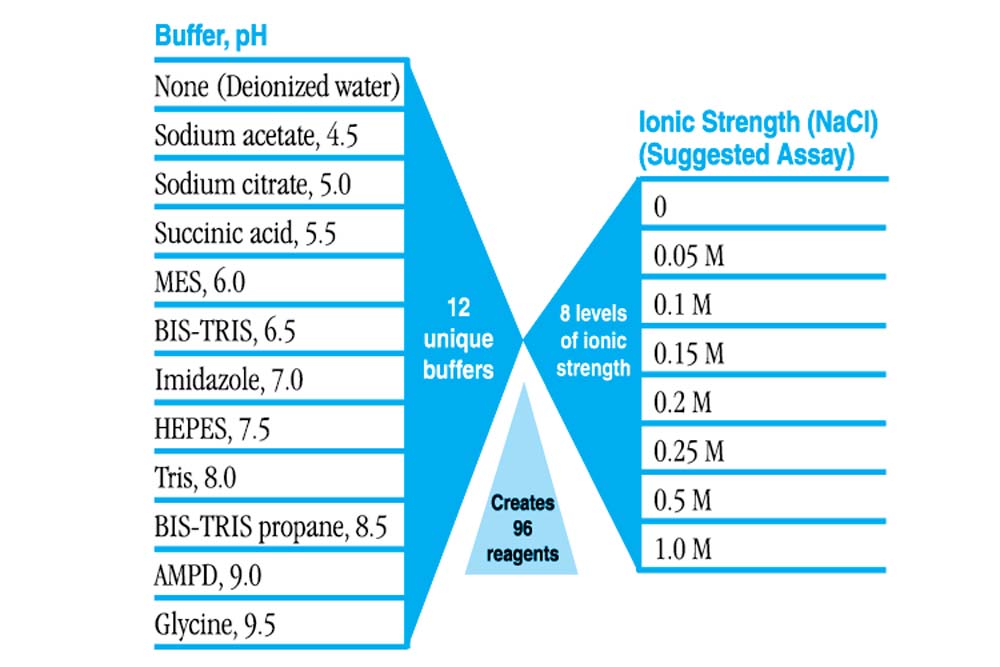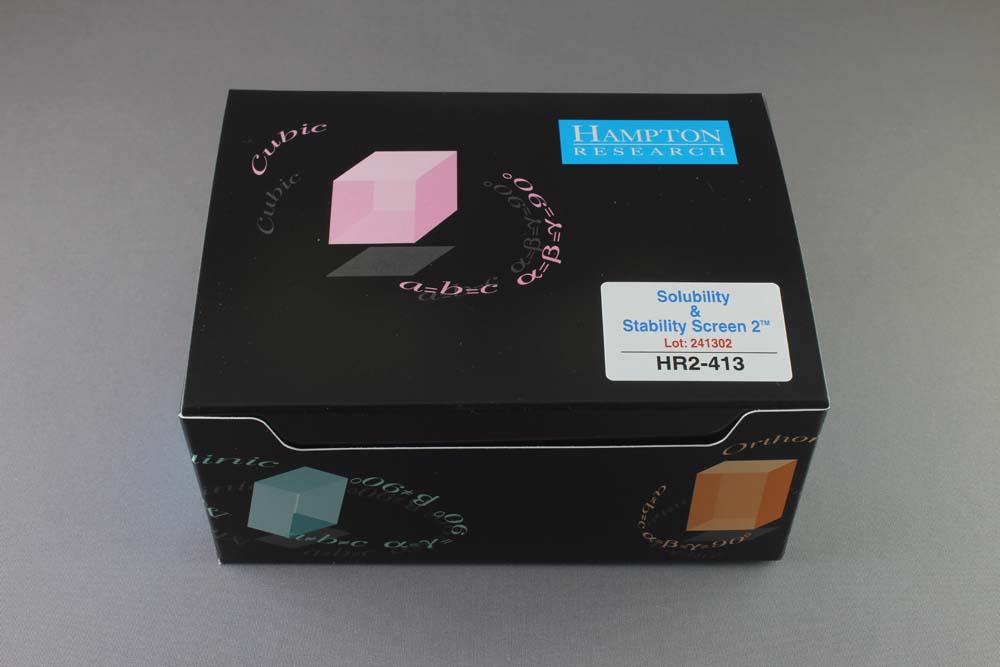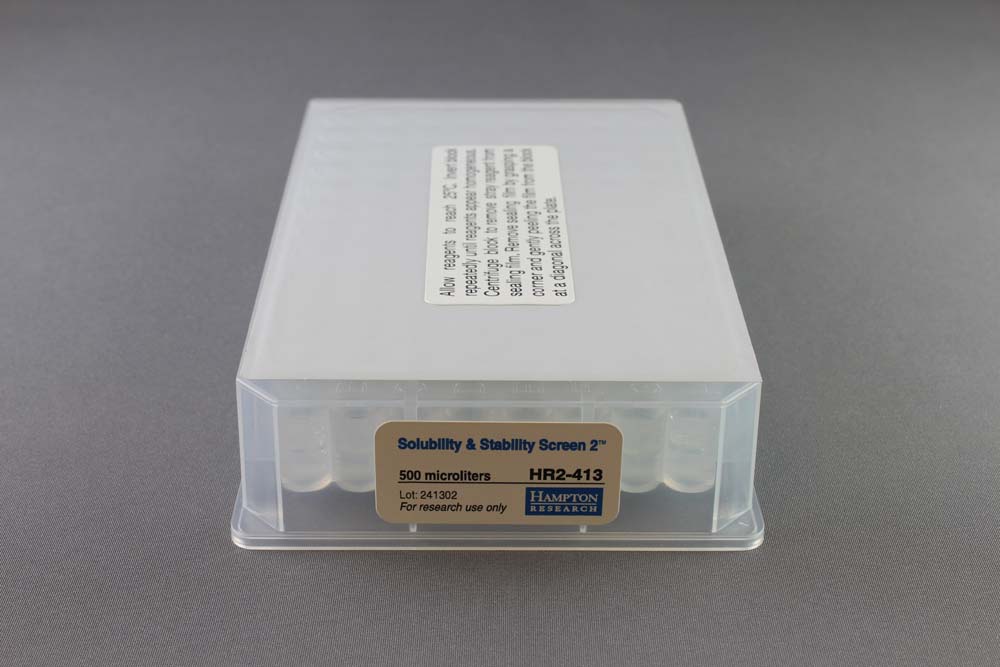Solubility & Stability Screen 2-Hampton 溶解度和稳定性筛选 2
上海金畔生物代理Hampton research品牌蛋白结晶试剂耗材工具等,我们将竭诚为您服务,欢迎访问Hampton research官网或者咨询我们获取更多相关Hampton research品牌产品信息。


Products > Optimization Screens > Solubility & Stability Screen 2 > Solubility & Stability Screen 2
Solubility & Stability Screen 2
Applications
- Solubility & Stability Screen 2 is designed to assist in the identification of optimal buffer, pH and ionic strength formulations that promote protein solubility and stability
- Sample buffer optimization for crystallization, cryo-electron microscopy, and NMR
Features
- Compatible with ThermoFluor (Differential Scanning Fluorimetry, DSF, Protein Thermal Shift) and Dynamic Light Scattering assays
- Formulation of 12 unique buffers, pH 4.5 – 9.5, versus 8 levels of ionic strength
- Evaluate varying ionic strength in the presence and absence of buffer
- Evaluate varying buffer type and pH in different levels of ionic strength
- 96 sterile filtered reagents
- Concentrated reagent formulation
- Developed at Hampton Research
Description
Protein solubility and stability are universally required in a wide range of applications, including general biochemical studies, the preparation of proteins in diagnostics and pharmaceuticals, structural biology and crystallization.
The preparation of a concentrated, soluble and stable protein sample can often be a difficult task as proteins often aggregate, precipitate or denature.
Protein solubility and stability is affected by many different chemical factors including pH, buffer type, ionic strength and protein specific additives. pH, buffer type and ionic strength are dominant protein solubility and stability variables that can be evaluated and optimized using the Solubility and Stability Screen 2.
No clear correlation between intrinsic properties of proteins and solubility and stability exist, so systematic screening can help to identify optimal sample buffer conditions. Protein solubility and stability screening, performed using Dynamic Light Scattering and ThermoFluor assays together with the Solubility and Stability Screens and Slice pH can be an extremely data rich, informative, efficient, and cost-effective method for the identification of sample buffer conditions that maximally stabilize a protein for protein purification, formulation, crystallization, and functional characterization.
Dynamic Light Scattering (DLS) is an established technique for determining the size, monodispersity and polydispersity of proteins in solution. DLS with a plate reader allows a multitude of buffers, pH, ionic strength, protein specific additives and temperature to be screened. Combining Solubility & Stability Screens with DLS, particle size and size distribution, unfolding of proteins, crystallizability, thermal stability, aggregation and solubility behavior and be evaluated in a high throughput format.
The ThermoFluor assay is an established technique for assessing protein thermostability in solution. ThermoFluor allows systematic assessment of many reagents simultaneously, uses only small a small amount of protein, and is accessible to anyone with a real-time PCR instrument.
Once an optimal buffer, pH and ionic strength is identified, the sample can be exchanged into the new optimal buffer. Using this optimized sample, further ThermoFluor assays with the Solubility & Stability Screen, Silver Bullets, Silver Bullets Bio and Additive Screen can be performed to identify protein specific additives that further promote solubility and stability of the protein.
ThermoFluor® is a registered trademark of Johnson & Johnson.
Protein Thermal Shift is a trademark of ThermoFisher.
Sypro® is a registered trademark of ThermoFisher.
溶解度和稳定性筛选 2 旨在帮助确定可促进蛋白质溶解度和稳定性的最佳缓冲液、pH 值和离子强度配方
结晶、低温电子显微镜和核磁共振的样品缓冲液优化
特征
与 ThermoFluor(差示扫描荧光法、DSF、蛋白质热位移)和动态光散射分析兼容
12 种独特缓冲液的配方,pH 4.5 – 9.5,与 8 种离子强度水平
评估存在和不存在缓冲液时不同的离子强度
在不同离子强度水平下评估不同的缓冲液类型和 pH 值
96 种无菌过滤试剂
浓缩试剂配方
在汉普顿研究中心开发
描述
蛋白质的溶解性和稳定性在广泛的应用中普遍需要,包括一般生化研究、诊断和药物中的蛋白质制备、结构生物学和结晶。由于蛋白质经常聚集、沉淀或变性,因此制备浓缩、可溶且稳定的蛋白质样品通常是一项艰巨的任务。蛋白质溶解度和稳定性受许多不同化学因素的影响,包括 pH 值、缓冲液类型、离子强度和蛋白质特定添加剂。 pH、缓冲液类型和离子强度是主要的蛋白质溶解度和稳定性变量,可以使用溶解度和稳定性筛选 2 进行评估和优化。
蛋白质的内在特性与溶解性和稳定性之间不存在明确的相关性,因此系统筛选有助于确定最佳的样品缓冲条件。使用动态光散射和 ThermoFluor 分析以及溶解度和稳定性筛选和切片 pH 进行的蛋白质溶解度和稳定性筛选可以是一种数据极其丰富、信息丰富、高效且具有成本效益的方法,用于鉴定最大程度稳定的样品缓冲条件用于蛋白质纯化、配制、结晶和功能表征的蛋白质。
动态光散射 (DLS) 是一种确定溶液中蛋白质大小、单分散性和多分散性的成熟技术。带有读板器的 DLS 可以筛选多种缓冲液、pH 值、离子强度、蛋白质特定添加剂和温度。将溶解度和稳定性筛选与 DLS、粒度和粒度分布、蛋白质展开、结晶性、热稳定性、聚集和溶解行为相结合,并以高通量形式进行评估。
ThermoFluor 检测是一种用于评估溶液中蛋白质热稳定性的成熟技术。 ThermoFluor 允许同时对多种试剂进行系统评估,仅使用少量蛋白质,任何拥有实时 PCR 仪器的人都可以使用。
一旦确定了最佳缓冲液、pH 值和离子强度,就可以将样品更换为新的最佳缓冲液。使用这种优化的样品,可以使用溶解度和稳定性筛选、Silver Bullets、Silver Bullets Bio 和 Additive Screen 进行进一步的 ThermoFluor 检测,以识别进一步促进蛋白质溶解性和稳定性的蛋白质特异性添加剂。
ThermoFluor® 是强生公司的注册商标。
Protein Thermal Shift 是 ThermoFisher 的商标。
Sypro® 是 ThermoFisher 的注册商标。
HR2-413 Solubility and Stability Screen 2




CAT NO
HR2-413
NAME
DESCRIPTION
0.5 ml, Deep Well block format
PRICE
$276.00
cart quote
Support Material(s)
 HR2-413 Solubility & Stability Screen 2 Documents
HR2-413 Solubility & Stability Screen 2 Documents HR2-413 Solubility & Stability Screen 2 SDS
HR2-413 Solubility & Stability Screen 2 SDS Solubility & Stability Screen 2 Formulation & Scoring Data
Solubility & Stability Screen 2 Formulation & Scoring DataRelated Item(S)
- Individual Solubility & Stability 2 Reagents
References
1. A thermal stability assay can help to estimate the crystallization likelihood of biological samples. Marquez et al. Acta Cryst. (2011). D67, 915-919.
2. The combined use of the ThermoFluor assay and ThermoQ analytical software for the determination of protein stability and buffer optimization as an aid in protein crystallization. Kevin Phillips and Andres Hernandez de la Pena. Current Protocols in Molecular Biology 10.28.1-10.28.15 April 2011.
3. Thermofluor-based optimization strategy for the stabilization and crystallization of Campylobacter jejuni desulforubrerythrin. Romao et al. Protein Expression and Purification 81 (2012) 193-200.
4. Optimization of protein solubility and stability for protein nuclear magnetic resonance. Bagby S, Tong KI, Ikura, M. Methods Enzymol. 2001;339:20-41.
5. High-Density Miniaturized Thermal Shift Assays as a General Strategy for Drug Discovery. Pantoliano et al, Journal of Biomolecular Screening, Volume 6, Number 6, 2001.
6. Thermofluor-based high-throughput stability optimization of proteins for structural studies. Ericsson, U.B. et al, Anal Biochem. 2006 Oct 15;357(2):289-98. Epub 2006 Aug 10.
7. Comparison of fluorescence and light scattering based methods to assess formation and stability of protein-protein complexes. J. Kopec, G. Schneider. Journal of Structural Biology 175 (2011) 216-223.
8. Enhancing recombinant protein quality and yield by protein stability profiling. Mezzasalma TM, Kranz JK, Chan W, Struble GT, Schalk-Hihi C, Deckman IC, Springer BA, Todd MJ. J Biomol Screen. 2007 Apr;12(3):418-28.
9. Optimization of protein purification and characterization using ThermoFluor screens. Boivin S, Kozak S, Meijers R. Protein Expr Purif. 2013 Oct;91(2):192-206. doi: 10.1016/j.pep.2013.08.002. Epub 2013 Aug 12.
10. The use of differential scanning fluorimetry to detect ligand interactions that promote protein stability. Frank H Niesen, Helena Berglund & Masoud Vedadi. Nat Protoc. 2007;2(9):2212-21.
11. Use of dynamic light scattering to assess crystallizability of macromolecules and macromolecular assemblies. Ferre-D′Amare AR1, Burley SK. Structure. 1994 May 15;2(5):357-9.
12. Crystallizing proteins – a rational approach? D′Arcy A. Acta Crystallogr D Biol Crystallogr. 1994 Jul 1;50(Pt 4):469-71.
13. Protein Crystallization. Techniques, Strategies, and Tips. A Laboratory Manual. Edited by Terese M. Bergfors. International University Line. 1999; 27-38.
